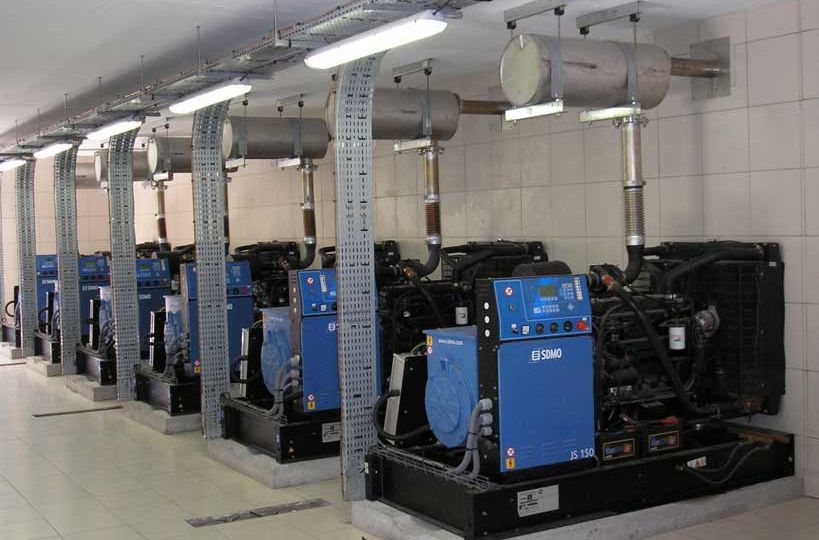Optimizing the operational efficiency and reliability of power generation systems, the strategy of paralleling multiple generators surpasses the conventional reliance on a singular generator setup. This methodology not only introduces redundancy, bolstering both reliability and adaptability in power generation schemes but proves invaluable in scenarios demanding an uninterrupted power supply. The integration of multiple generators to the bus significantly augments the chances of sustained power amidst generator failures, a critical factor in life-safety applications.
Navigating through fluctuating power demands becomes seamless with a multi-generator setup, enabling individual generator optimization for efficient load management. The cost-benefit analysis often favors multiple smaller generators over a singular large unit, especially when space constraints or power requirements present unique challenges. Notably, smaller generators facilitate easier installation solutions, including rooftop setups due to their lighter weight, and maintenance operations proceed uninterrupted, ensuring life-safety loads remain powered.
The paradigm of generator paralleling, refined over thirty years, has seen significant advancements in control capabilities. The integration of complex paralleling functionalities, once the exclusive domain of external, custom-programmed programmable logic controls (PLCs), is now a standard feature in certain generator controllers, marking the shift to onboard paralleling. This methodological shift has garnered broad acceptance while simultaneously addressing and mitigating associated risks.
Onboard Paralleling System Unveiled
A prototypical scenario involves the incorporation of KOHLER’s APM603 controllers within a power distribution and automatic transfer switch (ATS) framework. The APM603 controller orchestrates load sharing and synchronization across up to eight generator sets, streamlining generator and load management, with optional integration of a master control panel for overarching system command (See Figure 1). The power distribution switchboard serves as the nexus for generator set connectivity, establishing a unified bus and accommodating necessary breakers for individual generators and load management tailored to specific user requirements. The pivotal role of ATSs in discerning optimal power sources and executing load transfers becomes evident in this setup.
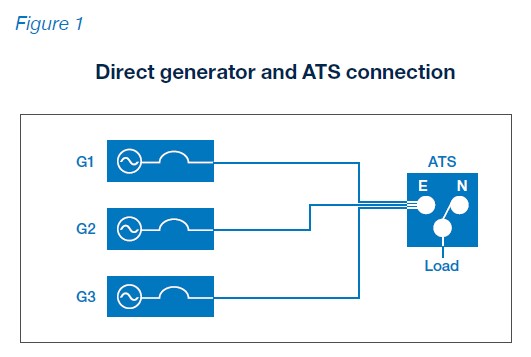
Installation and Service Perspectives
The North American installations of generators, ATSs, and power distribution switchboards fall under the jurisdiction of the National Electric Code (NEC), demanding a system-wide compliance approach rather than isolated equipment certification. The local Authorities Having Jurisdiction (AHJ) embody the interpretative authority over NEC documentation, basing system approval on comprehensive review encompassing components, connectivity, and installation protocols.
Optimal design considerations extend to servicing and troubleshooting facilitation, emphasizing the need for strategic component isolation to ensure maintenance activities do not necessitate extensive system shutdowns. Strategic placement of breakers and disconnection mechanisms significantly enhances routine maintenance efficiency.
Configurational Insights
Direct Generator-ATS Connectivity: This minimalist configuration, illustrated in Figure 2, offers an economical and space-efficient solution despite certain inherent limitations, specifically in accommodating ATS’s UL1008 listing criteria concerning lug amperage ratings and wiring configurations.
Switchboard with Bus Breaker: Enhancing serviceability through bus breaker incorporation, this configuration achieves a streamlined connection between generators and ATSs, thereby simplifying installation and reducing costs. Notably, the approach enables critical load segmentation via multiple ATSs, as depicted in Figure 2.1.
Multiple ATSs with their own breaker means loads can be separated based on criticality, especially emergency versus nonemergency loads. With loads separated via ATS and breakers, an area with a fault can be isolated without impacting other loads. This allows the system to continue operation, supplying power to the most critical loads.
For example, if a short circuit occurs, the breaker closest to the short circuit source should trip. If the loads are not isolated with a breaker per ATS, the single breaker will trip, disconnecting all loads. Without a breaker, it is not possible to isolate the loads and the entire system will shut down.
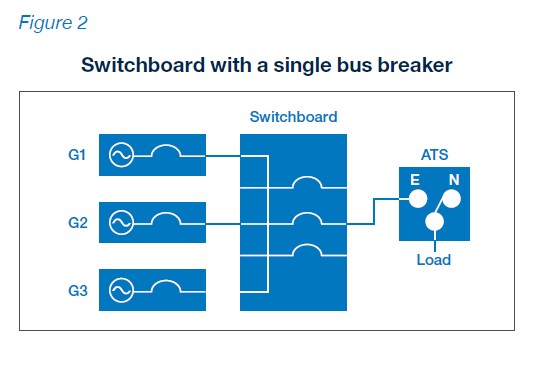
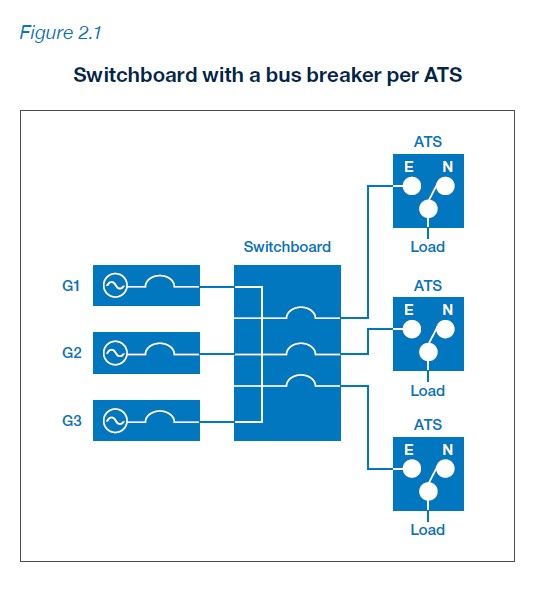
Breaker Pair per Generator in Switchboard Design: Offering superior serviceability, this design ensures uninterrupted power provision during maintenance operations. Each generator’s connection includes a dual breaker system for maximal isolation, effectively allowing for N + 1 design servicing without compromising system integrity. The implications of this design are further elaborated in Figures 3 and 3.1, highlighting the system’s flexibility and adaptability to evolving power demands.
It is possible to isolate each generator and prevent power reaching the load side of its breaker. Using two breakers for maximum isolation is the safest approach. There is no need to shut down the entire system to service one generator, the manual breaker on the switchboard would have to be opened to guarantee no power on the generator breaker load side. Without a switchboard breaker, the ATS would have to be switched to manual and left on normal.
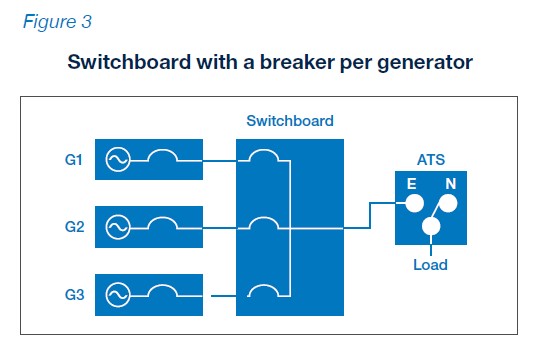
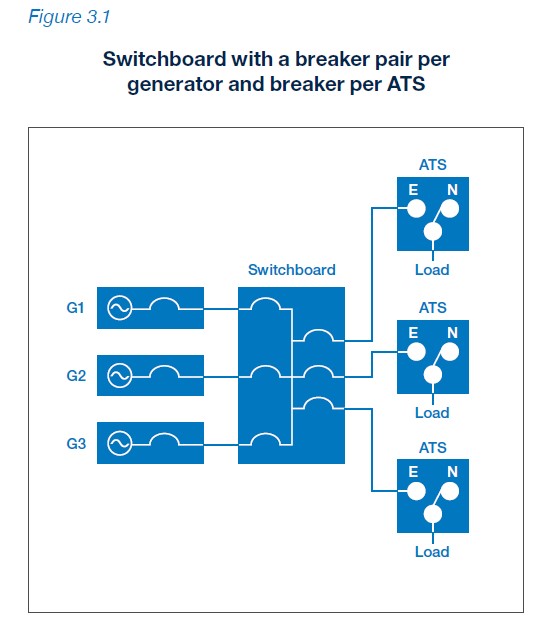
Reflections
Designing a generator system that embraces paralleling demands meticulous consideration of numerous factors, chief among them being safety, serviceability, and cost-effectiveness. Achieving a balance between flexibility and cost considerations requires engaging with suppliers whose expertise encompasses a broad equipment spectrum, ensuring tailored system performance under diverse operational conditions.


